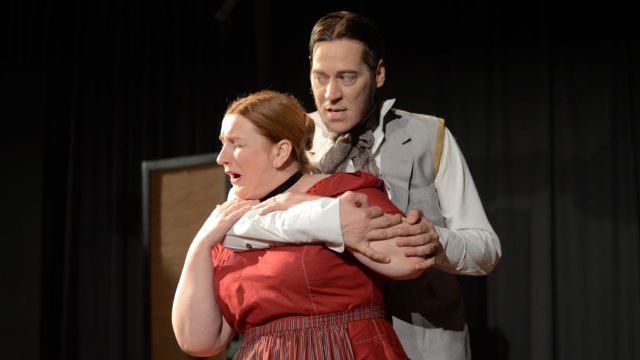Sweeney Todd
Mention Sweeney Todd today and one automatically thinks of Sondheim’s brilliant masterpiece. One forgets that the story of a barber who cuts his customers throats and whose bodies end up in meat pies has been around for centuries. In fact fourteenth century France is reputedly the first time the tale was documented. The story became a staple of melodrama in late 18th century London, and this version by Brian J. Burton is actually based on George Dibdin Pitt’s play The String of Pearls or the Fiend of Fleet Street and premiered regionally in the UK at the Crescent Theatre Birmingham in 1962.
While most of the familiar plot points are covered in his play it’s verbose and the songs don’t help. Burton’s score is basically a collection of pastiche 1800s parlour songs, mainly solos, with interminable verses.
 This was Nash’s first musical and it certainly stretched the resources of the company. Melodrama requires a certain acting style and director Sandra Harman was fortunate to have Nash regular Dan Lane on hand to bring the right type of villainy to the pivotal role of the grizzly barber. His Sweeney, which elicited boos from the mainly senior audience, was a villain to juicily hiss. Gleefully dispatching victims to his cellar from his infamous chair, his performance was the nearest thing to genuine melodrama in the production.
This was Nash’s first musical and it certainly stretched the resources of the company. Melodrama requires a certain acting style and director Sandra Harman was fortunate to have Nash regular Dan Lane on hand to bring the right type of villainy to the pivotal role of the grizzly barber. His Sweeney, which elicited boos from the mainly senior audience, was a villain to juicily hiss. Gleefully dispatching victims to his cellar from his infamous chair, his performance was the nearest thing to genuine melodrama in the production.
Holly Gilbert’s turn as heroine Johanna was fine except for some pitchy vocals, while James Meggitt, who was outstanding in Nash’s Never the Sinner, proved once again what an acting asset he is to the company giving a solid performance of Jarvis Williams.
A brief and lascivious moment of fun was had by Christopher Lynagh as the too-often imbibing Dr. Lupin, and Alison Pattinson as the blowsy Mrs Lovett.
Accents ranged from cockney to anywhere on the planet, and more attention to detail of the costumes would have helped create a better 1840s London look, but Stuart Crisp’s piano accompaniment was always accomplished.
Sweeney Todd wouldn’t be Sweeney Todd without the blood and gore which this production delivered at the finale when Sweeney slit his throat and the blood poured out. It was a fitting end to the tale and finally gave the audience their horror fix.
Peter Pinne
Subscribe to our E-Newsletter, buy our latest print edition or find a Performing Arts book at Book Nook.

